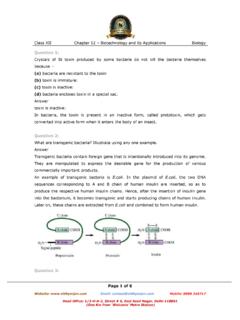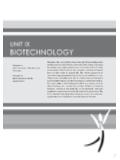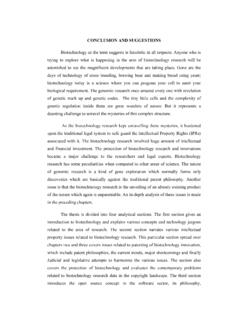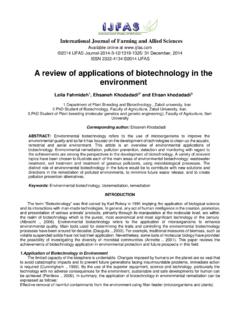Transcription of BIOTECHNOLOGY: AN OVERVIEW Modern biotechnology has ...
1 1 OverviewModern biotechnology has integrated several disciplines , varying from physics, chemistry, mathematics, biology, engineering, economics, law and management. The extraordinary developments occurring in biotechnology throughout the world has lead to significant changes in world commerce, as well as in human healthcare and agriculture sectors. Production of vaccines employing recombinant DNA methods is one example of its potential application. Pharmacologically active compounds from plants and marine organisms can now be isolated effectively using biotechnology . Progress in agricultural biotechnology will make our society less dependent on sustained harvest, which is often subjected to the vagaries of weather or chapter makes you familiar with the developments in biotechnology field and its applications in health care and agriculture.
2 biotechnology : AN OVERVIEW Unit1 OVERVIEWOVERVIEW2 The development of technologies that use living organisms or substances derived from them for the benefit of mankind led to the establishment of field of biotechnology . Thus, biotechnology is now defined as Any technological application that uses biological systems, living organisms or derivatives thereof to make or modify products or processes for specific uses (Food and Agriculture Organization). Humans have for centuries practiced biotechnology . They have used biotechnology to make bread, cheese, and beers and wines, to breed strong and productive animals, and to increase the yield of crops by selecting seeds from particularly desirable plants.
3 The Modern biotechnology is based on the fundamental knowledge of biosciences and thus, truly interdisciplinary in nature (Fig. 1). It has already made its presence felt in our daily life in many ways and now providing new opportunities for career advancement. The making of curd, bread, wine, and beer originated in prehistoric kitchens and the process leading to the development of these products came to be known as fermentation. Around 2000 BC, the Egyptians knew that when crushed dates were stored, a pleasantly intoxicating material was produced at first but if the mixture was allowed to stand for a longer time, it turned sour to yield vinegar, the strongest acid known to antiquity.
4 By 1500 BC, the use of germinated cereals (malt) for the preparation of beer from bread leaven (a mass of yeast) on a cereal dough and the formation of wine from crushed grapes, were established as technical arts in Mesopotamia, Palestine and Egypt. The ancients also observed that the formation of beer, wine or vinegar was followed by changes that led to the liberation of noxious odors, thus showing putrefaction for plant materials as compared to the more rapid decay of animal or human tissues. The practical arts of preserving animal foods drying, smoking, curing, pickling in brine, and treatment with granular salt -- were well developed in the prehistoric Near East and Europe.
5 The well-known mummification procedures in Egypt used the technique of dehydration with a mixture of salts, largely sodium century it was observed that fermentation could be classified into three groups on the basis of final of of alcohol, of acidAntoine Lavoisier provided the chemical basis for the nature of alcoholic fermentation by using analytical techniques for the quantitative estimation of carbon. PerspectivesChapter as causative agents of fermentationIn the early 19th century, Nicolas Appert, a French manufacturer of confectionery who distilled spirits and food products, described methods for preserving foods by putting them into tightly closed vessels that were then heated in boiling water this marked the beginning of the canning industry.
6 Gay Lussac examined Appert s closed heated vessels and found that they lacked oxygen. This led to the belief that oxygen was necessary for fermentation. The construction of achromatic compound microscope demonstrated in 1837 that the agents of fermentation are living organisms. Charles Cagniard Latour in 1838 described the involvement of brewer s yeast in alcoholic fermentation based on: (i) its constant occurrence in fermentation, (ii) cessation of fermentation under the conditions that killed yeast, such as boiling, treatment with arsenate, etc. and (iii) it was evoked and increased by the process itself - a phenomenon that applies to living organisms 1857, Louis Pasteur published his first report on formation of lactic acid from sugar through fermentation.
7 It was already known that lactic acid is produced from sugar and that addition of chalk to fermentation mixture markedly increases the amount of lactic acid produced. Using a microscope, Pasteur showed the presence of lactic yeast, which is the agent for the making of curd and confirmed the presence of L-lactic acid using a polarimeter. In 1860, he presented a detailed report on alcoholic fermentation and concluded: 4(i)The act of fermentation is a phenomenon, which is unique, and very complex, as it can be a phenomenon correlated with life, giving rise to multiple products such as succinic acid, glycerin etc.
8 All of which are necessary. (ii)There is never any alcoholic fermentation without there being simultaneously the organization, development, and multiplication of the globules which are already formed. (iii)He held the same views on lactic fermentation, butyric fermentation, fermentation of tartaric acid etc. (iv)He did not comment on the chemical act of cleavage of the sugar. (v)Fermentation appears to be a physiological phenomenon. (vi)Fermentation is a consequence of anaerobic ancestors have developed their own kitchen technologies with the help of fermenting bacteria, like Lactobacillus, Leuconostoc, Lactococcus, Enterococcus, Pediococcus etc leading to the development of a wide variety of yummy dishes that we relish today (Table 1).
9 The preparation of curd is a household recipe known to us for centuries. You too can prepare curd using the following mother s recipe (Fig. 2):Have you observed your mother making curd at home? Depending on the size of the family and average consumption, she has arrived at her own quantitative approach. Assuming a family of four consumes 200 ml/person of curd, she takes 800-1000 ml of milk, warms/cools it to lukewarm temperature (~37oC). Then she takes a teaspoon of the previous day s curd and distributes it uniformly in one liter of milk by stirring it. Assuming that it is a warm summer day, the curd is ready in about four hours.
10 The raw material, milk, has been converted completely into a semisolid product in four hours by addition of only one teaspoon of raw material, a white homogeneous slightly sweet liquid, has been converted into a semisolid, sour tasting appears to be both a physical as well as a chemical change during the OF THE CURDO bservations The 19th century saw the growth of industries linked to fermentation, which gave rise to products like wine, beer, and whisky. This period also saw the growth of canned food industry, which helped in the preservation of food for a longer time and made them available during off-seasons.












